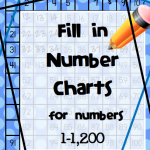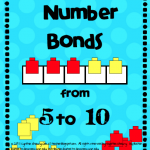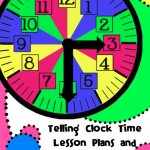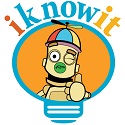Free $25 Gift Card and Free Products Giveaway!!!
Hop on over to an Apple for the Teacher for a Milestone Giveaway! She is giving away a $25 TPT gift card and many free products! WooHoo!

Everything in My Store is on Sale February 25th!!!

Everything in my store will be on sale and in many other Teacher Pay Teachers stores as well. Hop on over to stock up on some sale items!
Using Number Sense with Larger Numbers and a Freebie!
Thanks to the snow day (or shall I say ice day), I finally finished these number charts! Back in the fall I had the idea for this product because I was working with a group of intervention children and they just weren’t able to tell me what 1,000 more or less than a number was when the number had more than four digits. After the second grade standards, there are no standards that have children count past 1,000. I think somewhere, someone who wrote the standards just assumed that children would be able to pick up on these patterns, but many times they aren’t able to see these patterns without explicit teaching. That is what these number charts are meant to help teachers do. In celebration of a snow day (2 snow days now), and over 600 fb followers, I made a free product with charts counting by 500.
Here is the main product that has number charts counting by 100, 500, and 10,000. There are charts that count to 10,000; 100,000; and 1,000,000! These will help students begin to see the patterns of larger numbers and help give you a basis for discussing rounding. Not only that, but they increase in difficulty giving you a way to either scaffold or differentiate for your students! Here is a peek at the complete set of number charts….

You might also be interested in these fill in number charts with smaller numbers:
This Helped a SPED Kid Learn Subtraction Regrouping!
I posted earlier about a strategy that helped a struggling SPED student add with regrouping. Now, I am sharing the strategy I taught this same child to learn subtraction with and without regrouping.

Thank you to Lovin Lit and Educasong for the clip art!
Above there are two examples. One of the examples is with regrouping and the last one is without regrouping. This strategy will work both ways. I admit I have been using the rhyme that a couple of teachers have gotten from Pinterest…”More on top, no need to stop. More on the floor, go next door, and get ten more.” I have kids recite this first. The rhyme works very well so I use it. Anyhow, I have the kids always circle the number on the bottom in subtraction. The circle represents their head. Then they make dots to count up until they get to the top number. The dots are like their fingers. To get the difference they count how many dots they drew. Simple, easy, and if kids can make the jump to use their fingers, they can go ahead and don’t have to draw dots. I did this because I found some students don’t know how to effectively use their fingers to count up yet.
You may also like Addition Intervention Strategies:

Family Math Night Fun!
Well, I have been scurrying around like a squirrel hiding nuts (and maybe going nuts) these last few days getting ready for our Family Math Night. I usually plan this as close as I can to our 100th day of school, which happens to be this Thursday! While getting ready for this event, I have thought about a game I recently made, which first grade really enjoyed! This game is called Bubble Gum Pop and is centered around adding and subtracting 10’s and 1’s on the hundreds chart. The game is already differentiated and would be wonderful as a take home game for parents to enjoy with their children! There is very little prep to this game other than gathering some game pawns and deciding which way you want to use to make a spinner. There is even an extra engagement factor if you decide to use real bubble gum (flat pieces) for game pawns!
Here is the fun spinner! Kids place five pawns on the board to start with (scroll farther to see the board). Then they move those pawns down one square if they land on +10, up one square if they land on -10, to the right one square if they land on +1, and to the left one square if they land on -1. If students land on the wild space they can move their pawn anywhere on the board.

If students bump into one another, then they automatically knock the other pawn out. Also, if students land outside the perimeter of the chart, their opponent is out. The object of the game is to knock your opponent’s game pawns off of the board. Below you can see a sample game in action.

Here is a look at the game board.

I will be posting pictures of our Family Math Night soon if you are still needing ideas to help plan yours.
This Helped a SPED Kid Learn Addition Regrouping!
After you sit a while with a child who is obviously trying to figure something out and having little success, you try other strategies. I was sitting with a sweet little 3rd grader who has had a difficult life. She has eyes full of hope, and I know her eyes well because last year that is all I knew…she had to wear a face mask all year. A liver transplant had required her to wear a mask to prevent infections. She is such a hard worker and that makes me really want to do so much for her.

Ok, so back to the math strategies! When I would work with this child, she would have a hard time keeping track of which number to put in her head and which number to count on her fingers. She would forget when to stop counting on her fingers. This was a lot for her to manage. Finally, I thought about having her draw to represent her head and fingers so she could keep track of it. I know this doesn’t look like rocket science and there is probably already something similar out there, but this worked for her (and me). I told her that she was to look at the two numbers in the column and choose the larger one. Then I asked her to circle that number. I told her the circle represents the number that you keep in your head. After that, I instructed her to draw dots beside the smaller number to be pictures of her fingertips that she would count up on. She did this successfully and remembered this the next day. This will even work with more digits. Next week I plan on trying a similar strategy for subtraction. I hope maybe this can help some of your SPED kids out there who you just aren’t sure what to do with :).
Happy New Year 2015!!!!!!!
I know, I know, I am a little late in my New Year’s greeting! I hope you had a restful time from the normal day to day bustle. I managed to catch up on some family visiting and some cleaning for sure. The cold weather kept me from feeling like super cleaning woman so I refrained in several cleaning areas :)!
I know that many of you are concerned about the upcoming PARCC assessment or similar assessment. For those of you taking the PARCC assessment in paper and pencil, these items are already posted on the website now here.
Further there are now more helpful sites emerging that are helpful for PARCC practice. One of these such sites is Illustrative Mathematics. This site has practice items that are very much like the performance based questions on the PARCC assessment like below.
The best site of all is a practice test site called Ten Marks which gives students digital PARCC like questions with multiple choice and multiple response answer choices. Students can be assigned questions with the click of a common core standard. These assignments can then be taken on the computer or iPad. The results are immediately made available to the teacher. If students miss a question they are given the opportunity to watch a video about what they missed while they are doing the assignment. The program is free and so easy to use however, you must pay a fee for the best version. This is definitely worth taking a look at and the teachers L-O-V-E it.
I hope these few ideas help you get a head start on the upcoming testing season!
Merry Christmas!!!

Thank you to Educlips for the beautiful illustration of this adorable penguin!
Your Kids Aren’t Learning Their Addition Facts?…Try This (Part 7)
After using doubles and tens facts to learn one more and two more than all of those sums, that only leaves students with two facts to learn!!!
I allow students to tell me ways that these two facts can be easy to learn for them. Most students say that 3+6 is 9 so it is close to a ten fact. Some may be more comfortable with 3 +5, but after spending time talking about patterns with students, they will easily be able to discuss a way to get to this fact using a known fact. The thing that is uncomfortable about using 6+4 is that students have to go backwards and it is uncomfortable for them to go backwards in counting. Students favor going forward…cause more is better (like the commercial! :)) Also, 8+5 to me is an oddball. I can think of no easy way to get to this fact, but most students will say that 8 + 5 is close to 8+4 which is 12 so they know that 8+5 makes 13. Other students will say they know 8+2 is 10 so they can count up 3 more. I really don’t like that they have to count up 3 more, but at least it is better than counting up 5 from eight.
I will have to say that after working with intervention groups with all of these fact strategies, their answers aren’t as immediate as I would like, and at times they still use their fingers. I believe they still use their fingers because it is comfortable to them—more comfortable than thinking. After a strategy is learned it is imperative that they still practice with flash cards so that the facts remain fresh in their minds. I don’t work with a student population that readily has parents practicing with them at home on flashcards so the only extra practice they get is with me.
I plan on posting some of the materials I used to practice facts with the kids soon.
You may also like:

Your Kids Aren’t Learning Their Addition Facts? Try This…Part 6
If you have been following the previous posts, then you will see the progression of teaching number facts strategies. Nearly the last part of teaching addition facts focuses around doubles and doubles plus 2. I think this is one of the hardest strategies because kids may not readily see the double when it is two numbers away. With a little thinking and prodding, however, they will see the fact without using their fingers. Line the numbers up side by side so that students can see examples of both sets of numbers–the helping fact and the double plus 2.

Again, when having students recognize patterns and see relationships, I like to write them out of order so that students don’t say that the numbers are counting by 2’s etc. If students struggle to see the patterns, underline numbers to help them focus on what you want them to see such as underlining the second addends on both sets of equations. Then underline the sums on both sets of equations. Step back for a few moments and let the prolonged silence aid students in thinking about the relationships in the two sets of numbers. Give students time enough to generalize about how doubles can be a helping fact. * Note that students have already learned sums of 10 and 10s plus 2 more so they have strategies for 5+7, 4+6, and 6+8.
After this, students only have a few more facts to learn!!
You may also like:
Thank you Erin Cobb! Frames Courtesy of Lovin Lit.
































